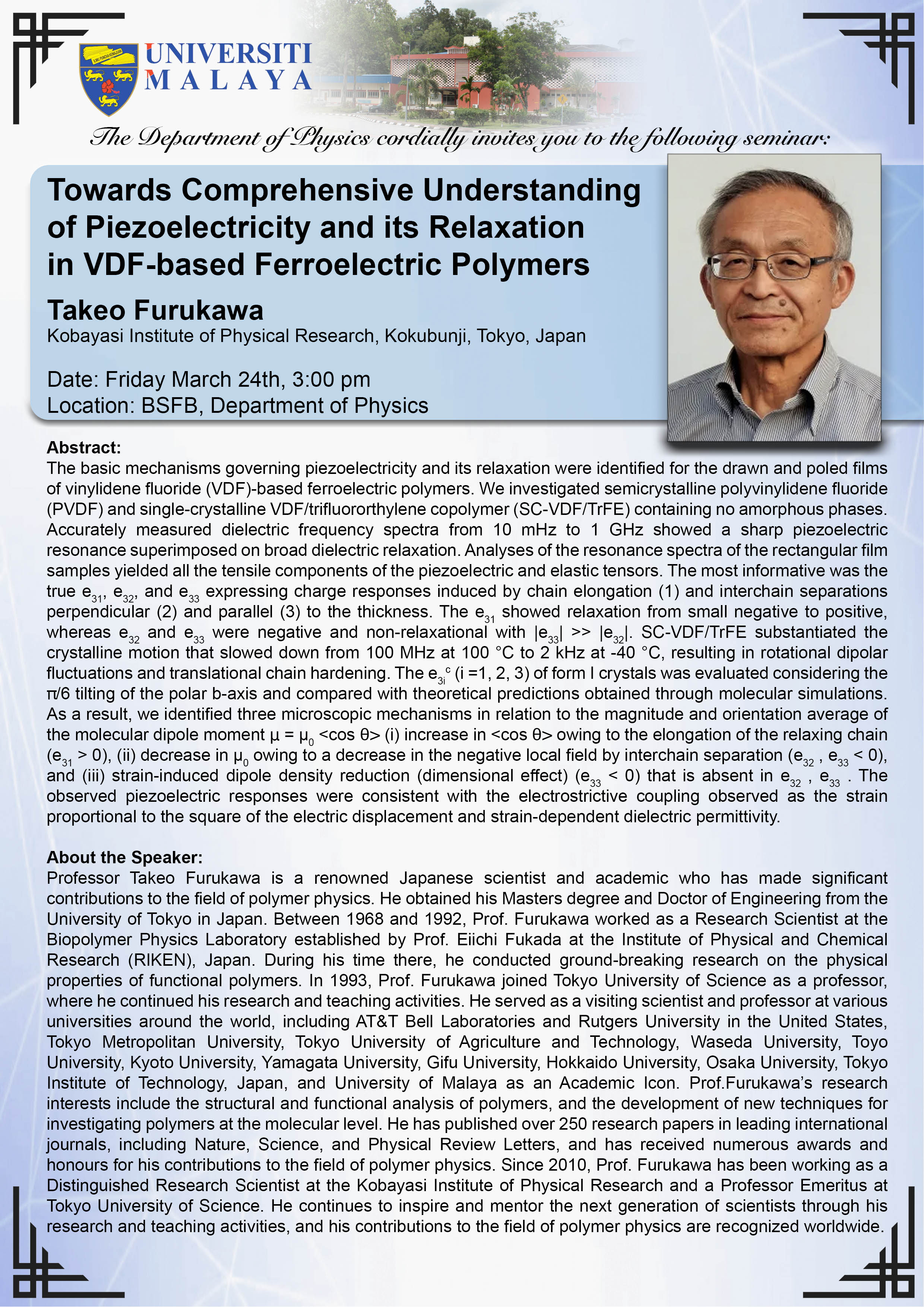Dear all,
The Department of Physics Cordially Invites you to the Following Colloquium:

Title: Towards Comprehensive Understanding of Piezoelectricity and its Relaxation in VDF-based Ferroelectric Polymers
Speaker: Takeo Furukawa, Kobayasi Institute of Physical Research, Kokubunji, Tokyo, Japan
Date: Friday March 24th 3:00 - 4:00 pm
Venue: BSFB, Department of Physics
Abstract: The basic mechanisms governing piezoelectricity and its relaxation were identified for the drawn and poled films of vinylidene fluoride (VDF)-based ferroelectric polymers. We investigated semicrystalline polyvinylidene fluoride (PVDF) and single-crystalline VDF/trifluororthylene copolymer (SC-VDF/TrFE) containing no amorphous phases. Accurately measured dielectric frequency spectra from 10 mHz to 1 GHz showed a sharp piezoelectric resonance superimposed on broad dielectric relaxation. Analyses of the resonance spectra of the rectangular film samples yielded all the tensile components of the piezoelectric and elastic tensors. The most informative was the true e31, e32, and e33 expressing charge responses induced by chain elongation (1) and interchain separations perpendicular (2) and parallel (3) to the thickness. The e31 showed relaxation from small negative to positive, whereas e32 and e33 were negative and non-relaxational with |e33| >> |e32|. SC-VDF/TrFE substantiated the crystalline motion that slowed down from 100 MHz at 100 °C to 2 kHz at -40 °C, resulting in rotational dipolar fluctuations and translational chain hardening. The e3ic (i =1, 2, 3) of form I crystals was evaluated considering the π/6 tilting of the polar b-axis and compared with theoretical predictions obtained through molecular simulations. As a result, we identified three microscopic mechanisms in relation to the magnitude and orientation average of the molecular dipole moment μ = μ0
About the Speaker: Professor Takeo Furukawa is a renowned Japanese scientist and academic who has made significant contributions to the field of polymer physics. He obtained his Masters degree and Doctor of Engineering from the University of Tokyo in Japan. Between 1968 and 1992, Prof. Furukawa worked as a Research Scientist at the Biopolymer Physics Laboratory established by Prof. Eiichi Fukada at the Institute of Physical and Chemical Research (RIKEN), Japan. During his time there, he conducted ground-breaking research on the physical properties of functional polymers. In 1993, Prof. Furukawa joined Tokyo University of Science as a professor, where he continued his research and teaching activities. He served as a visiting scientist and professor at various universities around the world, including AT&T Bell Laboratories and Rutgers University in the United States, Tokyo Metropolitan University, Tokyo University of Agriculture and Technology, Waseda University, Toyo University, Kyoto University, Yamagata University, Gifu University, Hokkaido University, Osaka University, Tokyo Institute of Technology, Japan, and University of Malaya as an Academic Icon. Prof.Furukawa’s research interests include the structural and functional analysis of polymers, and the development of new techniques for investigating polymers at the molecular level. He has published over 250 research papers in leading international journals, including Nature, Science, and Physical Review Letters, and has received numerous awards and honours for his contributions to the field of polymer physics. Since 2010, Prof. Furukawa has been working as a Distinguished Research Scientist at the Kobayasi Institute of Physical Research and a Professor Emeritus at Tokyo University of Science. He continues to inspire and mentor the next generation of scientists through his research and teaching activities, and his contributions to the field of polymer physics are recognized worldwide.
Thank You.